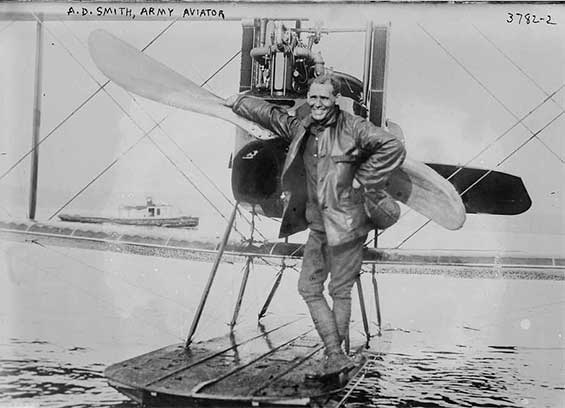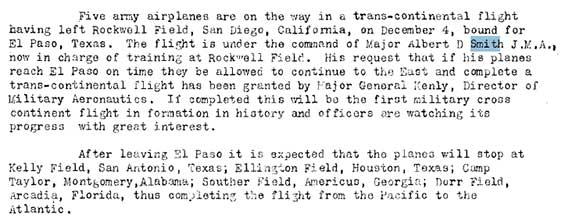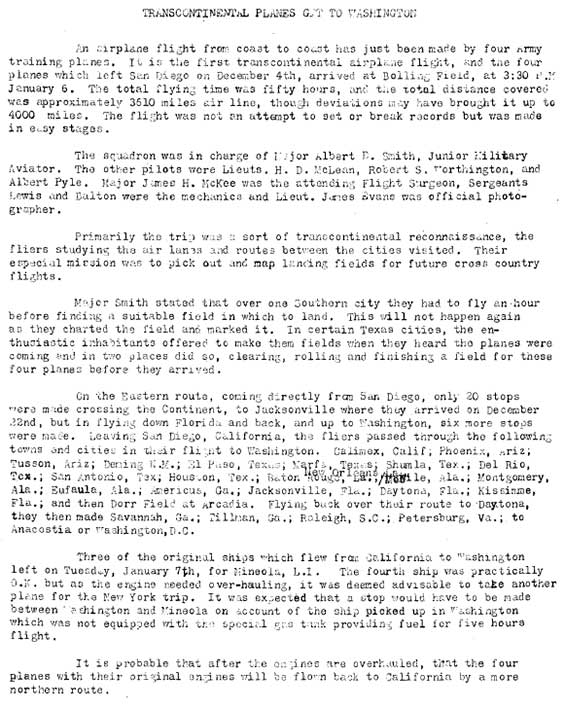|
Albert Smith was signed in the Davis-Monthan Register once, on Thursday, March 28, 1929 at 11:00AM. Based in Phoenix, AZ, he arrived at Tucson from Phoenix, AZ. He carried one passenger he identified as "Dickason." They flew in the Fleet Husky Smith identified as NC8601. They remained on the ground only 15 minutes before departing to Douglas, AZ. Image below is from the Library of Congress via ancestry.com.
Albert D. Smith, 1916, Location Unknown (Source: ancestry.com)
 |
A.D. Smith was born February 6, 1887 in Farley, MO. Being born on that date, he was one of the oldest pilots to sign the Register (he would have been 42 when he landed at Tucson in March 1929). The 1900 U.S. Census, his first, placed him living with his family in Salt Fork, OK. His family consisted of his father, mother, two sisters and two brothers. His father's occupation was coded as "Farmer."
According to his NASM biographical file (left sidebar), he graduated high school at Lamont, OK. He entered the army at a young age to serve in the infantry in the Philippines 1904-1907. He left the army and married Nellie Delinda Miller (1886-1968) in 1908. In 1910, the Census placed him at age 21 living in Alameda, CA at 219 Bay View Avenue. He lived with his wife, Nellie (23). His occupation was listed as "Conductor" on the "Electric R.R."
Around the same time, he helped build a glider. In 1911 he moved with Nellie to Montana to take up farming. There he met a former balloon showman who was building an airplane. Smith traded a horse, harness and a wagon in return for half-interest in the aircraft. A short statement by Smith was found in his NASM biographical file that described his first flight, below. Don't try this at home.
During the winter of 1912 and the spring of 1913, [I] assembled a Curtiss type biplane with bamboo outriggers in a garage in Spokane, WN [sic].
This plane had been constructed on the job from tubing, bamboo and wood obtained from local business firms. The motor was a Maximotor of approximately forty horse power. The propeller was hand made from a laminated block of wood, the tips were protected by using ladies' hose glued firmly in place.
Roebling had come out with their first flexible cable, the heaviest of which was one sixteenth inch. This was used on all controls. All rigging was with piano wire. Turnbuckles were fashioned on the job from motorcycle spokes.
Following several months taxiing up and down the field at Parkwater, WN [sic], just up the river from Spokane, with the throttle tied down, I untied the throttle and took off for my first flight on October 6, 1913. I had a wild ride and was scared stiff. After gaining control I circled the field and came in for my first landing from an elevation of about four hundred feet. The landing was surprisingly good, which climaxed the greatest thrill of my life. |
Maximotor Advertisement, Aerial Age Weekly, June 5, 1916 (Source: Web)
 |
What was a Maximotor you ask? See left. Nonetheless, Smith took to the air on an exhibition career. He took a contract with the Liberty Lake Park Board of Spokane, WA to drop copies of the Spokane Review over settlements in the area. He flew as far as Idaho and Montana and back to Spokane. The year ended with no cash and an airplane is poor shape.
Repairs were made and he flew the airplane through 1913 and 1914 before crashing due to engine failure while flying over Sand Point, WA. During this period, Smith and Nellie had one daughter, Alberta Delinda Smith (1912-1994) born on September 22nd. Smith and Nellie were divorced sometime before 1920, when Nellie was recorded as remarried.
Smith rejoined the army and enlisted in the Signal Corps on May 10, 1915. While in the army this time, on February 9, 1916, he made an unofficial world seaplane duration flight on 8:42:00 in one of the new Martin "S" seaplanes. And on September 2, 1916 he was involved in early radio communications from airplane to airplane as described in the extract below from this REFERENCE, page 14. Note mention of Register pilot Clarence C. Culver. Please direct your browser to his biography to learn that he was the electrical engineer who designed the aerial radio sets.
Smith formally registered for the draft in June 1917. His draft card is below. We learn that he was of medium height and build, brown eyes and hair, and partially bald. He was already instructing army pilots as a civilian on North Island, San Diego. He did not serve in Europe.
A.D. Smith WWI Draft Card, June 15, 1917 (Source: ancestry.com)
 |
As with many things, the details are in the fine print. If you look carefully at the diagonal printing at the lower left of this card, the text says, "If person is of African descent, tear off this corner." Some things change; some things remain the same. As you will learn in the boxed biography below,
On August 23, 1917 he was promoted to captain and was assigned to pilot training. At some point, he remarried to Katherine McRae. The 1920 Census placed him living in San Diego, CA in the household of his father-in-law. Katherine was with them. Smith's occupation was coded as "Air Service."
He was promoted to major in October 1917 and placed in charge of "experimental flying." A site visitor provided the following information that puts a fine point on Smith's 1917-18 activites.
"After joining the Air Service, Maj Albert D. Smith was assigned as adjutant to Lt Col Virginius Evans Clark, commander of newly-established McCook Field, Dayton, OH, on 27 Oct 1917. McCook was the Air Service's Experimental Engineering Station, responsible for testing and evaluating new aircraft & technologies, as well as determining suitability for production. Smith was assigned as Director of Flying at McCook, overseeing all full-flight testing of experimental aircraft. In modern terms, he was the Air Service's Chief Test Pilot. On 29 Jan 1918, he was assigned further responsibility for "all mechanics on test work whether at McCook Field or elsewhere."
"Just before 11am on 9 March 1918, Smith was flying a Nieuport 16 Scout (McCook tail no. P10, French serial no. 2474) over McCook Field. During a series of manuevers, the plane had an indeterminate failure and plunged nose first from an altitude of about 100 feet. The plane was destroyed and Smith injured. He was given first aid at the Field's hospital, then taken to Dayton's Miami Valley Hospital with a broken ankle, additional injuries to the chest and legs, and a "badly cut-up" face. I was unable to find a cause of the accident, but the Nieuports were known for a weak structure, being prone to flutter and, later (esp. the Nieuport 28) shedding their upper wing surfaces, leading to unrecoverable crashes.
"On 12 May 1918, Maj Smith was reportedly assigned to Wilbur Wright Field, the Army Air Service flight training field across Dayton from McCook Field. This is not to be confused with the later "Wright Field" (the current Area B of Wright-Patterson AFB), which took over the McCook Field functions in 1927. Wilbur Wright Field was located in what was subsequently called Patterson Field and is now Area A of Wright-Patterson AFB. In addition to its pilot training activities, it was also the location of additional test flying for McCook Field, usually involving larger aircraft that couldn't fit on McCook's small flying field or ones that were too dangerous to fly in close proximity to the city of Dayton. Mentions of Smith appear sporadically over the summer of 1918, but I was unable to find anything related to him and McCook Field from that point forward." |
Perhaps his history at McCook Field became scarce because he moved to the west coast to prepare for a trans-continental flight. Between December 4, 1918 and February 14, 1919, Smith led a group of four JN-4 aircraft from San Diego to Jacksonville, FL and on to New York. After a stay there, the formation left for San Diego. Smith was the only one to complete the return trip. It was the first time the army had flown a transcontinental round-trip (but see the "Round the Rim" flight performed by Register pilot Ernest E. Harmon in 1919). The Air Corps Newsletter (ACNL) for December 7, 1918 reported the departure of the group, below. Note that the article cites five aircraft. It appears the initial plan did not include New York.
Air Corps Newsletter, December 7, 1918 (Source: Webmaster)
 |
The ACNL for January 11, 1919 provided a progress report, below. Notice that the entourage landed at Tucson. They signed nothing, because the Register was not avialable at the field until 1925.
Air Corps Newsletter, January 11, 1919 (Source: Webmaster)
 |
The ACNL for February 15, 1919 provided another update, below. Smith's arrival at San Diego and the deadline for the Newsletter missed each other by a day. He was the only airplane to fly all the way back, arriving on the 14th. The total elapsed flying time was 109 hours, 25 minutes.
Air Corps Newsletter, February 15, 1919 (Source: Webmaster)
 steele_dm steele_dm |
Although the flight arrived in New York January 7, 1919, Smith came down with the flu and the return flight was delayed until January 26th. Copies of news articles found in his NASM dossier documented his flights across the country. One from March 2, 1919 reported that he acquired a Belgian police dog in New York, named it "Flu" and took him along on his return flight to San Diego. Smith stated that the dog took to flying just fine, and reckoned it was the first time a dog had flown coast-to-coast. He was probably correct.
In the fall of 1919, Smith was assigned to forest patrol in Oregon to spot fires. Besides individual patrols, he was tasked with an inspection trip in October as documented in the ACNL, below.
Air Corps Newsletter, November 15, 1919 (Source: Webmaster)
 |
In March 1920, he was the first to demonstrate the DeHavilland DH-4B. Here he suffered an injury while looping close to the ground, the ground coming up before the loop was completed. He was fortunate to survive. Smith left the army in 1923 due to an injury suffered in the crash.
The 1925 San Diego city directory listed Smith and Katherine living at 4816 Monroe Avenue. His occupation was unlisted. From 1930-1940 he was with TWA as pilot and executive. The 1930 Census placed him (age 42), Katherine (33) and son, Kenneth (2; 1928-2001) living in Glendale, CA at 427 West Glenoaks Blvd. They owned their home, valued at $4,000 on the Census form. That address today is a modern, 3-storey apartment building. They had a lodger named Clyde Grandbois (20) living with them. Smith's occupation was coded as "Pilot," "Aeroplane."
A.D. Smith in TWA Skyliner Magazine, August 1939 (Source Woodling)
 |
The 1939 city directory for Albuquerque, NM placed him and Katherine at 216 North 9th Street. His occupation was identified as Division Superintendent for T.W.A. The 1940 Census placed him in the same job. He, Katherine and son Kenneth (age 11) lived in Albuquerque in a home they owned that was valued at $5,000 on the Census form. Photograph, right, captured Smith at leisure.
According to information in his NASM dossier, in October 15, 1940, Smith was recalled to active duty as Base Operations Officer and Supervisor, Army Extension School, Albuquerque Air Base, home of the 19th Heavy Bomb Group. To 1941, he had accumulated 6,752 flight hours, including 2,500 in multi-engined aircraft, 600 hours at night, and 163 navigational trips in excess of 1,000 miles.
He remained in the army for the duration of WWII, moving to Greenland, then later to the Azores. On November 28, 1945 he was ordered in front of a retirement board. He retired with the rank of Brigadier General.
The following, very brief biography appeared at ancestry.com, first published in 1958 in The Early Birds of Aviation "CHIRP" magazine. The magazine's article was an abridgement of another article that appeared in "Coronet." My notes are in [brackets].
THE ARMY'S INCREDIBLE SMITH
We are indebted to Horace Tuttle for sending in a February 1945 copy of the Coronet which presented a 7-page story of the exploits of Albert D. Smith who was called the "Army's Number-One Smith." Brig. Gen. Albert D. Smith ret, now lives at Balboa Island, California.
Smith had his first taste as an infantry private and was promptly sent to the Philippines to battle the Moros who were on the warpath. He landed back at San Francisco in 1906 in time to help fight the fires which accompanied the great earthquake. He left the army in 1907 to run his own ranch in Montana but his interest in airplanes lured him away, and in 1911 he flew his first plane which he and a friend built. That first flight ended in a crash landing, but in the years that followed he piled up thousands of hours in the air as a skilled pilot. He is the holder of Aero Club license #354.
A.D. became an army pilot and fought in both world wars, and many were his exploits and close calls in and out of service. As a corporal, he won the American hydroplane duration record of 8 hours and 42 minutes on February 19, 1916 [The airplane he flew was numbered AH-22 in the second alphanumeric series according to Baugher. Perhaps the photograph above shows him about that time.]. He is also credited with being the first man to make radio connections between plane and plane, and plane and ground [but see Register pilot Clarence Culver]. He was chosen by Arnold [Register pilot H.H. Arnold] as a trouble shooter whenever the army needed a man to do an impossible job.
In March 1918, Smith crashed at Wright Field, Dayton and was seriously injured, but he refused to stay long out of service. In 1919, he joined Col. H. H. Arnold's Northwestern Forest Fire Patrol which was undertaking a pioneering task to preserve our national forests, and his daring flights took him through the canyons and rough country. Because he never allowed his old injuries time to heal, he was let out of service for physical disability in 1923.
After working a small property in California for a time, he organized Scenic Airways [sic, but see also Parker Van Zandt) which flew tourists down into the Grand Canyon. Still later he joined an airline which merged with others to form TWA. He resigned a fine job with TWA in 1940 to go back into the Army, and he became operations officer at Albuquerque Air Base. Following other training assignments, Smith, now a Colonel, was chosen by Arnold to man a northern air base from which planes were flown to Europe. He was also sent to help Bernt Balchen conquer Greenland and keep it free of Germans.
After A.D. had done such a good job in Greenland, General Arnold sent him to a new base being built right under the nose of the enemy [Azores?], and he was likewise put back on flying status and made a Brigadier General.
During his many flying years, A.D. Smith, the Army's number-one Smith, performed many rescues and conquered many difficult projects.
This from The Early Birds of Aviation "CHIRP"
November 1958, Number 60 |
I have no information about his life after he retired from the army. Smith flew West from Newport Beach, CA, January 20, 1970.
---o0o---
Dossier 2.2.160
THIS PAGE UPLOADED: 06/08/17 REVISED: 02/09/18
|










